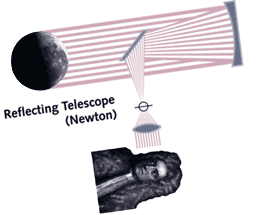|

TYPES
OF TELESCOPES

Refracting
Telescopes
Light enters
through a large convex (outward curving) glass lens called
the objective. This lens refracts, or bends, the light
toward the eyepiece, where it produces an image. One of
the main problems with refracting telescopes is a phenomenon
referred to as chromatic aberration, which causes objects
to appear to be surrounded by rainbow-colored halos. To
compensate for this problem, a special second lens is
mounted behind the main objective to focus more of the
colors of light at a single point. Because they can produce
"true" images (rather than the inverted images seen with
reflectors), refracting telescopes are useful both for
stargazing and land observation, such as bird-watching.

Reflecting
Telescopes
Reflecting
telescopes use a series of mirrors to gather and focus
light. In a Newtonian reflector, light passes through
the open tube of the telescope until it reaches the primary
parabolic mirror. This curved mirror reflects the light
rays to a secondary flat mirror, which reflects the light
to the eyepiece of the telescope. There the image (inverted)
is brought into focus. Because it is technically simpler
to build and support large, high-quality mirrors rather
than lenses, most large optical telescopes are of the
reflecting type. Reflectors in general yield the largest
aperture per dollar and account for about 90 percent of
telescopes used by amateurs. Advanced amateurs commonly
use an aperture of at least 152 millimeters (6 inches).

Catadiatropic
Telescope
Invented by
Bernhard Schmidt in 1930, the catadiatropic telescope
—
the
name means "reflecting and refracting"
—
employs
a combination of lenses and mirrors. Light passes through
a thin lens on its way to a spherical primary mirror.
The reflected light then hits a convex secondary mirror
and is transmitted to the focal point through a small
opening in the primary mirror. This configuration allows
the optics to be housed in a short tube. Compact and portable,
catadiatropic telescopes are popular among experienced
amateur astronomers.

|
![]()
![]()